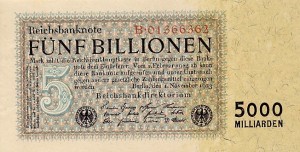 The past month there’s been a lot of talk about Greece leaving the Euro and finally, last Monday, news broke that a new austerity package, loans and the whole shebang was back on the table, and they could stay.
The past month there’s been a lot of talk about Greece leaving the Euro and finally, last Monday, news broke that a new austerity package, loans and the whole shebang was back on the table, and they could stay.
Yet, I have a feeling, they left anyway. The past month or so, Greeks have only been allowed to withdraw €60/day from their accounts. They can freely transfer money within the country and cannot transfer anything abroad.
But that sounds an awful lot like having two currencies to me. Cash-euros are worth more than bank-account euros because you can spend them abroad. Let us call cash euros Euro Marks or E-marks. Bank-euros you can only spend inside Greece. You can exchange E-marks for bank-euros at a rate of one-to-one in official channels, but E-marks are worth more to a person who needs to pay a foreign country for goods. Perhaps a business owner would pay you two bank-euros for one E-mark? You can get E-marks from bank-euros but at a very limited rate, so if you need more, you have to go to the black market and purchase them at the unofficial market rate of two to one.
You can pay your bills in bank-euros; for example rent, electricity. I believe that is the real purpose of the capital control. Greece has ridiculously high corruption and tax evasion, and by moving monetary transaction from the severely limited E-mark to the bank-euro, it becomes much easier to trace this and reduce tax-evasion.
This is of course a huge hassle if your day-to-day hobby is tax-evasion, black-market deals or your hobby just happens to frequent prostitutes who don’t accept bank-euros.
But fret not; you can just pay in goat cheese! Greeks love that stuff. Of course, having to carry around 2 pounds of feta to get the paper and a bottle of ouzo can be a bit inconvenient, so instead you could somehow make little pieces of paper for goat cheese options. Call them, I don’t know?, cheese is ost in Danish, so call them Ostmarks. You can exchange bank-euros for Ostmarks (but only a minor percentage of the economy uses bank-euros anyway as they tend to get stolen by the socialist government), and perhaps even skip the middle man and transfer directly between Ostmarks and E-marks.
Drink that bottle of ouzo and nobody can tell the difference between E and D, and you have two currencies, D-marks and Ostmarks – boom!, welcome to the split Germany where the Ostmark officially was worth the same as the D-mark but in reality wasn’t.
